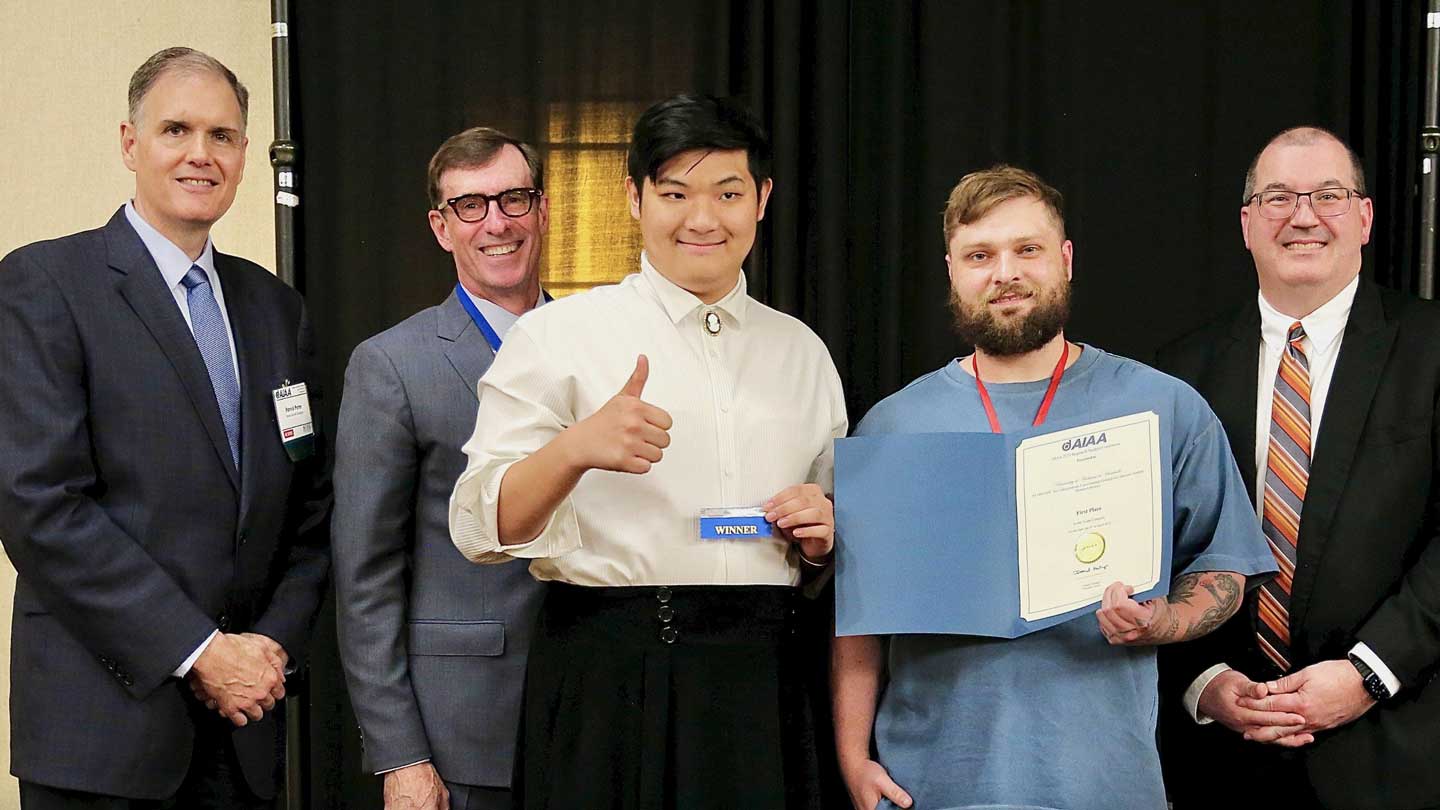
(L-R) Patrick Porter, Vice President, Flight Test & Flight Operations at Honda Aircraft Company; Clay Mowry, AIAA CEO and President of the International Astronautical Federation; Claude Blue, UAH aerospace engineering student, Research Lead of STARGATE project and President of Electric Propulsion Club, NASA Space Grant Scholar Jeffrey King, current STARGATE Chief Electrical Engineer and former Navy nuclear electrician; and Kurt Polzin, Chief Engineer - NASA’s Space Nuclear Propulsion Project.
Courtesy EPC
The Electric Propulsion Club at The University of Alabama in Huntsville (UAH) won first place at the 2025 American Institute of Aeronautics and Astronautics (AIAA) Conference Region II Student Conference in Raleigh, N.C. The award recognizes the student club’s development of a patent pending of new type of gridded ion thruster. An ion thruster is a form of electric propulsion that creates a cloud of positive ions which is then accelerated using electricity to create thrust.
“This award is for the STARGATE project team,” says Claude Blue, a rising senior in aerospace engineering, as well as research lead and president of the group at UAH, a part of The University of Alabama System. “The award was for our presentation and our research with our thruster development, in which we listed improved design philosophy, updated features, design linage, motivation, mistakes, low pressure testing results, plans for upcoming high vacuum test and future goals.”
Each presentation is made before three aerospace industry judges who critique the student work based on content, delivery, cohesion and applicability to the real world. “When your presentation is done, the judges ask difficult questions and judge you by your response,” Blue explains. “I think every engineering-focused university in the AIAA Region II presented at the conference. The teams category is one of the most competitive categories at the AIAA student conference, and this year we competed with around 70 teams. These are lessons you carry with you across your entire future career, and make you much more prepared as a research engineer.”
The AIAA is the world’s largest technical society dedicated to the global aerospace profession. Founded in 1963 through a merger between the American Rocket Society and the American Interplanetary Society, the group today boasts 30,000 members from 91 countries, along with 95 corporate members, representing more than 80 years of aerospace leadership.
“UAH is widely known and respected in the industry and one of the best universities because of what you can do here,” Blue notes. “It's possible to start your research group as an undergrad, find lab space and an advisor, get funding to pursue your ideas, pursue a patent when you have a good idea and have support across the department and faculty to see you succeed.”
The AIAA conference presentation was made by Blue, inventor of the STARGATE technology, along with Jeffrey King, a former Navy nuclear engineer. The team is also advised by Joseph Hayes, an aerospace engineer and current graduate student, who led the team last time UAH won the same award in 2021. Support and sponsorship for the project included the Alabama Space Grant Consortium, the UAH College of Science, Physics Department and Office of Technology Commercialization, as well as Blue Origin. In addition to the team’s Principal Investigator, Dr. Themistoklis Chronis, a UAH clinical assistant professor of physics and astronomy, support was also provided by Jon Buckley, UAH machine shop director.
“I feel proud of this university for everything it allowed us to do, for everyone here and their accomplishments, and for all the people in support of us,” Blue says. “I believe undergraduate research is important because it gives valuable lessons in inevitable failure. It is not about the results or outcome of your project, although that is also very important, or to out-do your peers in competing for opportunities, but gaining the experience of knowing why it's important to check your math twice, how to handle internal and external discourse, and how to deal with failure and use it to pave ways for future success.
“I came to UAH because I chose an environment rich in opportunities. There is no gap at all in terms of our skill abilities or how well we are trained.”